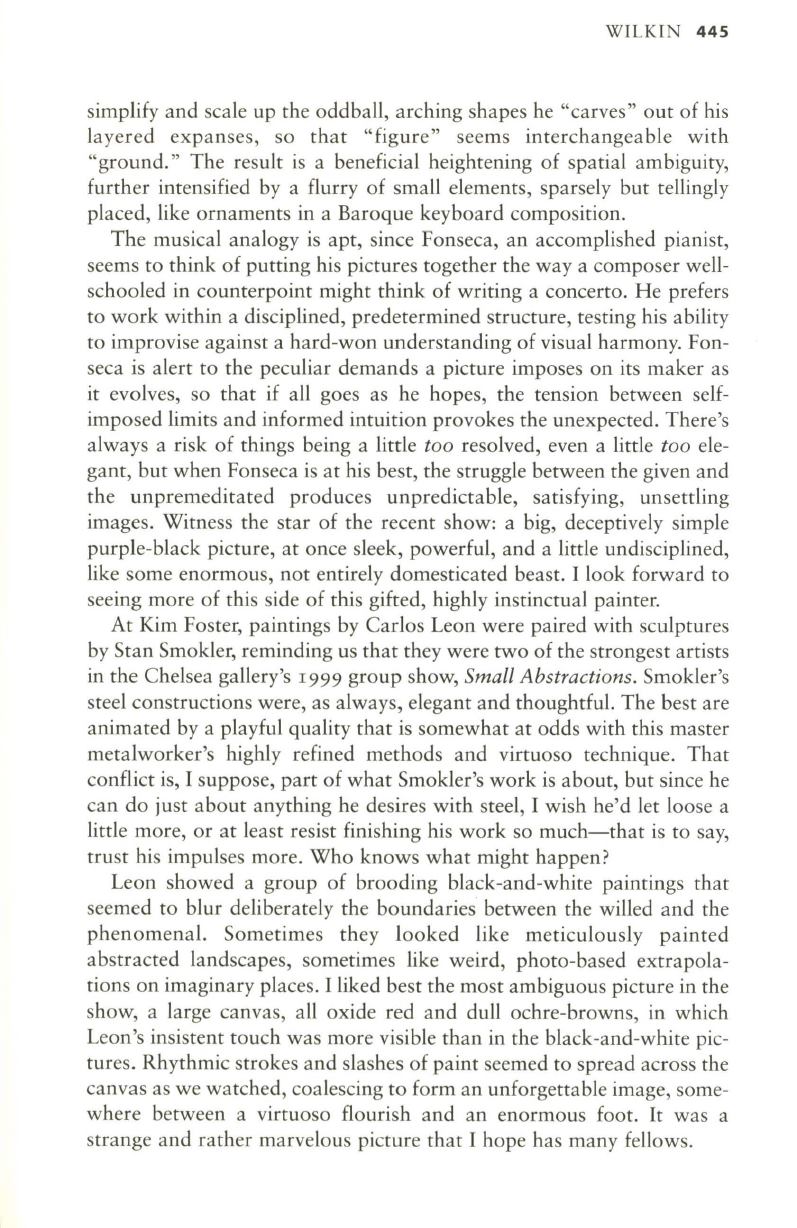
WILKIN
445
simplify and scale up the oddball, arching shapes he "carves " out of his
layered expanses, so that "figure" seems interchangeable with
"ground." The result is a beneficial heightening of spatial ambiguity,
further intensified by a flurry of small elements, sparsely but tellingly
placed, like ornaments in a Baroque keyboard composition.
The musical analogy is apt, since Fonseca, an accomplished pianist,
seems to think of putting his pictures together the way a composer well–
schooled in counterpoint might think of writing a concerto. He prefers
to work within a disciplined, predetermined structure, testing his ability
to improvise against a hard-won understanding of visual harmony. Fon–
seca is alert to the peculiar demands a picture imposes on its maker as
it evolves, so that if all goes as he hopes, the tension between self–
imposed limits and informed intuition provokes the unexpected. There's
always a risk of things being a little
too
resolved, even a little
too
ele–
gant, but when Fonseca is at his best, the struggle between the given and
the unpremeditated produces unpredictable, satisfying, unsettling
images. Witness the star of the recent show: a big, deceptively simple
purple-black picture, at once sleek, powerful, and a little undisciplined,
like some enormous, not entirely domesticated beast. I look forward to
seeing more of this side of this gifted, highly instinctual painter.
At Kim Foster, paintings by Carlos Leon were paired with sculptures
by Stan SmokIer, reminding us that they were two of the strongest artists
in the Chelsea gallery's
I999
group show,
Small Abstractions.
SmokIer's
steel constructions were, as always, elegant and thoughtful. The best are
animated by a playful quality that is somewhat at odds with this master
metalworker's highly refined methods and virtuoso technique. That
conflict is, I suppose, part of what SmokIer's work is about, but since he
can do just about anything he desires with steel, I wish he'd let loose a
little more, or at least resist finishing his work so much-that is to say,
trust his impulses more. Who knows what might happen?
Leon showed a group of brooding black-and-white paintings that
seemed to blur deliberately the boundaries between the willed and the
phenomenal. Sometimes they looked like meticulously painted
abstracted landscapes, sometimes like weird, photo-based extrapola–
tions on imaginary places. I liked best the most ambiguous picture in the
show, a large canvas, all oxide red and dull ochre-browns, in which
Leon's insistent touch was more visible than in the black-and-white pic–
tures. Rhythmic strokes and slashes of paint seemed to spread across the
canvas as we watched, coalescing
to
form an unforgettable image, some–
where between a virtuoso flourish and an enormous foot.
It
was a
strange and rather marvelous picture that I hope has many fellows.


